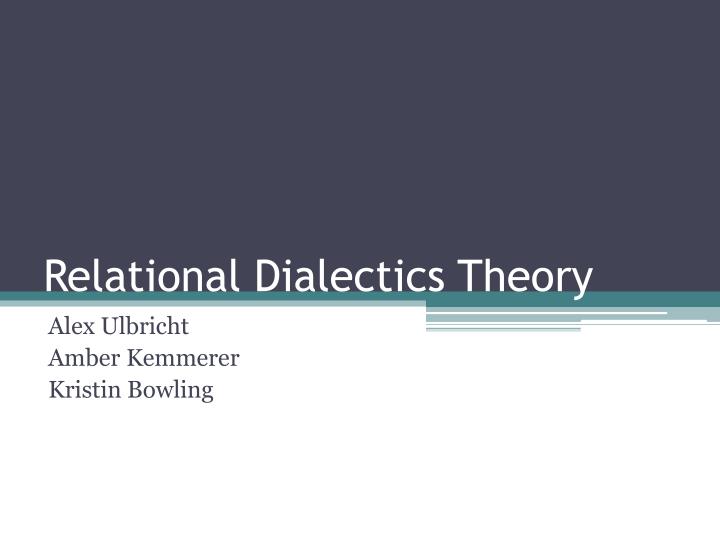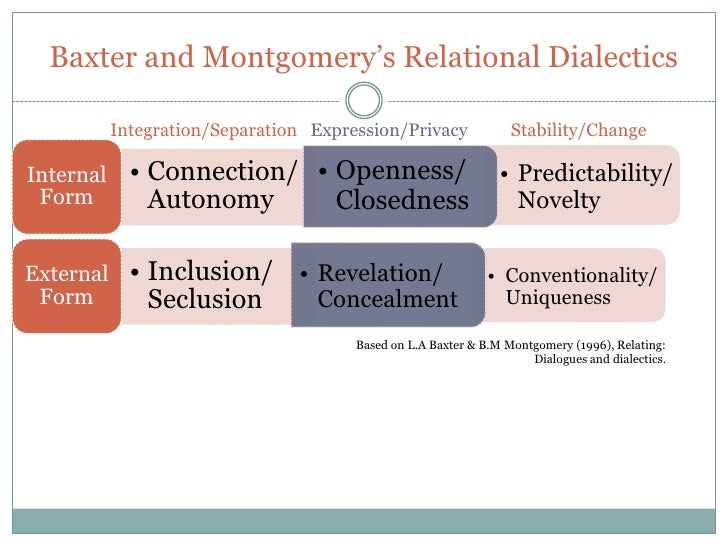

To dialectical theorists, dialectical tensions keep the relating process vibrant and alive, as parties navigate the unity of opposites in an ongoing manner.


This simultaneous "both-and" dynamic produces an ongoing dialectical tension or interplay between opposites. However, partners must also be different from each other in order to sustain autonomous identities.Ĭontradictory phenomena are yoked together at the same time that they negate one another. Partners must be similar to some extent in order to establish and sustain a common bond. For example, marriages require both similarities and differences between the partners. For example, we understand what "night" means only because we have a concept of "day." With interactive unity, the opposing phenomena are united in practice or in function as part of the same interacting system. The unity of identity is semantic or definitional unity. Interdependence can take two basic forms, which Irwin Altman and his colleagues (1981) referred to as the unity of identity and interactive unity. Opposites are unified if they are in some way interdependent. Barbara Montgomery (1993) has identified three kinds of oppositions: (1) oppositions that are mutually exclusive and exhaustive (e.g., openness versus non-openness) (2) oppositions that are mutual exclusive but not exhaustive (e.g., connection versus autonomy) and (3) oppositions that are complementary (e.g., dominance versus submissiveness). Three terms are important in understanding this definition: opposites, unified, and dynamic interplay.Ĭentral to the notion of opposition is mutual negation: Semantically, opposites are the antonyms of one another and function to nullify, cancel, undo, or otherwise undermine one another. A contradiction is the dynamic interplay between unified opposites. The central concept of dialectical theorists is the contradiction. This entry emphasizes the common features. Like any family, the various dialectical approaches share some features in common yet differ in others. Social dialectics is not a single theory but a family of theories (Montgomery and Baxter 1998). It brings together contributions from leading experts in the field, and gives much-needed insight in the subject of mathematical physics from a historical point of view.The fundamental assumption of social dialectical theorists is that all relationships-friendships, romantic relationships, family relationships-are interwoven with multiple contradictions. The purpose of the Symposium and this book is to gather and re-evaluate the current thinking on this subject.

Recently, much historical research has been done into mathematics and physics and their relation in this period. The link by which physical ideas had influenced the world of mathematics was not new in the 19th century, but it came to a kind of maturity at that time. Of course this problem is related to the links between institutions, universities, schools for engineers, and industries, and so it has social implications as well. The authors explain the various ways in which this science allowed an advanced mathematical modelling in physics on the one hand, and the invention of new mathematical ideas on the other hand. So the main question is: When and why did the tension between mathematics and physics, explicitly practised at least since Galileo, evolve into such a new scientific theory? The aim of this book is to analyse historical problems related to the use of mathematics in physics as well as to the use of physics in mathematics and to investigate Mathematical Physics as precisely the new discipline which is concerned with this dialectical link itself.


 0 kommentar(er)
0 kommentar(er)
